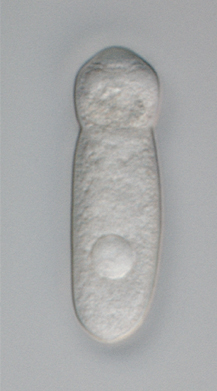Gregarine
| Gregarinasina | |
|---|---|
 |
|
| A live specimen of a septate (or cephaline) gregarine showing the distinctive "head"-like section of the trophozoite containing the epimerite at its anterior end. Septate gregarines are intestinal parasites of arthropods. | |
| Scientific classification | |
| Domain: | Eukaryota |
| (unranked): | SAR |
| (unranked): | Alveolata |
| Phylum: | Apicomplexa |
| Class: | Conoidasida |
| Subclass: | Gregarinasina |
| Orders | |
| Synonyms | |
|
|
Archigregarinorida
Eugregarinorida
Neogregarinorida
The gregarines are a group of Apicomplexan alveolates, classified as the Gregarinasina or Gregarinia. The large (roughly half a millimeter) parasites inhabit the intestines of a large number of invertebrates. They are not found in any vertebrates. However, gregarines are closely related to both Toxoplasma and Plasmodium, which cause toxoplasmosis and malaria, respectively. Both protists use protein complexes similar to those that are formed by the gregarines for gliding motility and invading target cells. This makes them an excellent model for studying gliding motility with the goal of developing treatment options for toxoplasmosis and malaria.
Gregarines occur in both aquatic and terrestrial environments. Although they are usually transmitted by the orofaecal route, some are transmitted with the host's gametes during copulation (Monocystis).
In all species, four or more sporozoites (the precise number depends on the species) equipped with an apical complex escape from the oocysts, a process called excystation, find their way to the appropriate body cavity, and penetrate host cells in their immediate environment. The sporozoites emerge within the host cell, begin to feed, and develop into larger trophozoites. In some species, the sporozoites and trophozoites are capable of asexual replication — a process called schizogony or merogony. Most species, however, appear to lack schizogony in their lifecycles.
...
Wikipedia
